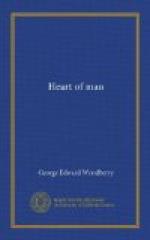VII
It is my last day at Taormina. I have seen the sunrise from my old station by the Greek temple, and watched the throng of cattle and men gathered on the distant beach of Letojanni and darkening the broad bed of the dry torrent that there makes down to the sea, and I wished I were among them, for it is their annual fair; and still I dwell on every feature of the landscape that familiarity has made more beautiful. The afternoon I have dedicated to a walk to Mola. It is a pleasant, easy climb, with the black ancient wall of the city on the left, where it goes up the face of the castle-rock, and on the right the deep ravine, closed by Monte Venere in the west. All is very quiet; a silent, silent country! There are few birds or none, and indeed I have heard no bird-song since I have been here. Opposite, on the other side of the wall of the ravine, are some cows hanging in strange fashion to the cliff, where it seems goats could hardly cling; but the unwieldy, awkward creatures move with sure feet, and seem wholly at home, pasturing on the bare precipice. I cannot hear the torrent, now a narrow stream, deep below me, but I see the women of Mola washing by the old fountain which is its source. There is no other sign of human life. The fresh spring flowers, large and coarse, but bright-coloured, are all I have of company, and the sky is blue and the air like crystal. So I go up, ever up, and at last am by the gate of Mola, and enter the stony-hearted town. A place more dreary, desolate to the eye, is seldom seen. There are only low, mean houses of gray stone, and the paved ways. If you can fancy a prison turned inside out like a glove, with all its interior stone exposed to the sunlight, which yet seems sunlight in a prison, and silence over all—that is Mola. The ruins of the fortress are near the gate on the highest point of the crag. Within is a barren spot—a cistern, old foundations, and some broken walls. Look over the battlement westward, and you will see a precipice that one thinks only birds could assail; and, observing how isolated is the crag on all sides, you will understand what an inaccessible fastness this was, and cannot be surprised at its record of defence.
Perhaps here was the oldest dwelling-place of man upon the hill, and it was the securest retreat. Monsignore, indeed, believes that Ham, the son of Noah, who drove Japhet out of Sicily, was the first builder; but I do not doubt its antiquity was very great, and it seems likely that this was the original Siculian stronghold before the coming of the Greeks, and the building of the lower city of Taormina. The ruins that exist are part of the fortress made by that governor who lost the city to the Saracens, to defend it against them on this side; and here it stood for nigh a thousand years, like the citadel itself, an impregnable hold of war. It seldom yielded, and always by treachery or mutiny; for more than once, when Taormina was sacked, its citadel and Mola remained untaken and unconquerable on their extreme heights. I shall not tell its story; but one brave man once commanded here, and his name shall be its fame now, and my last tale of the Taorminian past.




